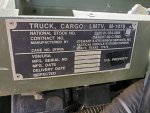I do not see any dash plates with the D on my 97 M1088? Did they hide it?
You shouldn't have to worry too much, they [supposedly] ALL got the upgrade, even if you have trouble seeing the "D" stamp. Then again it is the Army, so I'm sure there are a few trucks out there, but your chances of having one would be small still.
I'm not sure about this part, but I think that one way to tell is that the original driveshafts had yokes that the u-joints bolted to with u-bolts. So if yours are types with screw down caps, it should be good. I'm not 100% sure, but I think I remember that being one of the recommended fixes, to remove the u-bolt style u-joints.
I know it's a lot of money, but I still recommend you have your driveshafts checked and rebalanced. While it seems that only a small percentage of people have big issues, when they do it destroys the engine, or more. When my engine got wrecked, I couldn't feel an abnormal vibration from in the cab, even though I'd had the truck a year or so and put 1000-2000 miles on it. So it's not entirely obvious, and I'm usually quick to notice new sounds, smells, etc. that the truck is making.
Other reading I've done mentioned that the research into the vibration would best be fixed with RZEPPA style joints but they also lacked strength and were nixed in favor of the bigger single cardan fix("D" stamped)
The Rzeppa style joints are stronger. The engineering report said they failed the water intrusion test, but that the engineers suspected that could be overcome, and that the Rzeppa joints were the recommended solution.
I have yet to see a document detailing why, but I assume the Army just used the bigger shafts and u-joints because it was a cheaper, faster solution (little or no re-engineering involved, all off-the-shelf parts). You have to figure that they were desperate for a fast solution, because they had put a 35MPH limit on their entire new fleet of LMTVs. That had to be very frustrating, and embarrassing... good thing the USSR was gone and wasn't watching anymore.
Can these slip yokes be assembled out of phase? My HMMWV has an aligning spline that soldier proofs the shaft assembly. All the u-joints on the HMMWV front shaft are out of phase with each other on purpose.
Yep.



